#fossil from Jurassic Coast
Explore tagged Tumblr posts
Photo

BRADFORDIA LIOMPHALE Fossil Ammonite – Inferior Oolite, Jurassic Coast, Burton Bradstock, Dorset, UK
This listing features a beautifully preserved Bradfordia liomphale fossil ammonite discovered in the iconic Inferior Oolite strata of the Jurassic Coast at Burton Bradstock, Dorset, UK. This rare and scientifically notable ammonite dates back to the Middle Jurassic period and is an excellent example of the intricate shell structure and evolutionary significance of ammonites during this era.
Geological Unit: Inferior Oolite Group
Formation: Burton Bradstock Beds
Geological Period: Middle Jurassic
Stage: Early Bajocian
Biozone: Parkinsonia zone (based on locality association)
Depositional Environment: Shallow marine carbonate platform
Order: Ammonitida
Superfamily: Stephanoceratoidea
Family: Morphoceratidae
The specimen was carefully unearthed by our dedicated fossil hunters, Alister and Alison, on 17 January 2025. Following discovery, it was meticulously cleaned, stabilised, and prepped by Alison to highlight its ribbed pattern, detailed coiling, and preserved sutures.
Your fossil is set within a natural matrix from the site, retaining context from its original stratigraphic layer. A scale cube (1cm) is included in the photos for precise sizing—please refer to the image for complete dimensions. The photo represents the exact item you will receive.
All of our Fossils are 100% Genuine Specimens & come with a Certificate of Authenticity.
Whether you're an experienced fossil collector, a museum educator, or a geological enthusiast, this authentic ammonite fossil is a valuable and impressive addition to any collection.
#Bradfordia liomphale fossil#Jurassic ammonite#Burton Bradstock ammonite#Dorset fossil#ammonite UK fossil#certified ammonite#ammonite collector item#Inferior Oolite ammonite#fossil from Jurassic Coast#Mesozoic marine fossil#rare ammonite species#ammonite matrix fossil
0 notes
Text

Rare beautiful golden pyrite ammonite fossils from the world famous Jurassic Coast beach of Charmouth, Dorset UK.
Photo : 📷 Fms.fossils.
Dr Fiann Smithwick
613 notes
·
View notes
Text
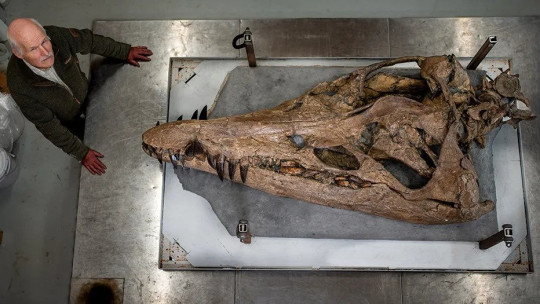
Gigantic Skull of Prehistoric Sea Monster Found on England’s ‘Jurassic Coast’
The remarkably well-preserved skull of a gigantic pliosaur, a prehistoric sea monster, has been discovered on a beach in the county of Dorset in southern England, and it could reveal secrets about these awe-inspiring creatures.
Pliosaurs dominated the oceans at a time when dinosaurs roamed the land. The unearthed fossil is about 150 million years old, almost 3 million years younger than any other pliosaur find. Researchers are analyzing the specimen to determine whether it could even be a species new to science.
Originally spotted in spring 2022, the fossil, along with its complicated excavation and ongoing scientific investigation, are now detailed in the upcoming BBC documentary “Attenborough and the Jurassic Sea Monster,” presented by legendary naturalist Sir David Attenborough, that will air February 14 on PBS.

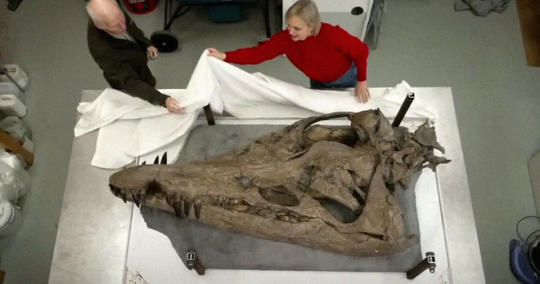
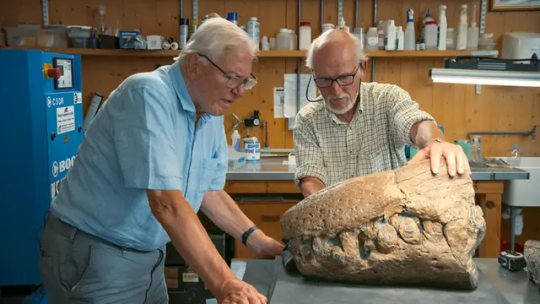
Such was the enormous size of the carnivorous marine reptile that the skull, excavated from a cliff along Dorset’s “Jurassic Coast,” is almost 2 meters (6.6 feet) long. In its fossilized form, the specimen weighs over half a metric ton. Pliosaurs species could grow to 15 meters (50 feet) in length, according to Encyclopaedia Britannica.
The fossil was buried deep in the cliff, about 11 meters (36 feet) above the ground and 15 meters (49 feet) down the cliff, local paleontologist Steve Etches, who helped uncover it, said in a video call.
Extracting it proved a perilous task, one fraught with danger as a crew raced against the clock during a window of good weather before summer storms closed in and the cliff eroded, possibly taking the rare and significant fossil with it.
Etches first learned of the fossil’s existence when his friend Philip Jacobs called him after coming across the pliosaur’s snout on the beach. Right from the start, they were “quite excited, because its jaws closed together which indicates (the fossil) is complete,” Etches said.
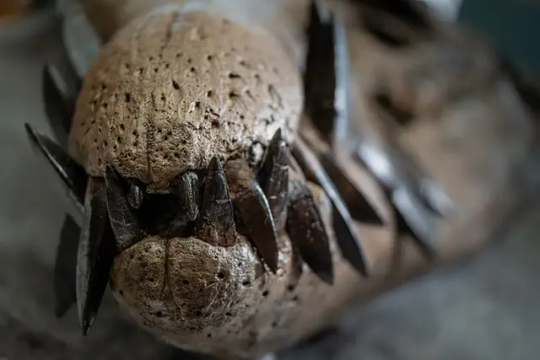
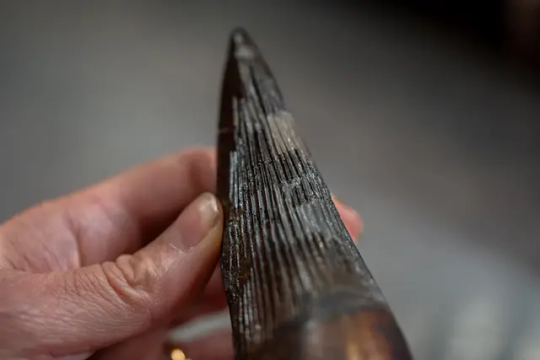
After using drones to map the cliff and identify the rest of the pliosaur’s precise position, Etches and his team embarked on a three-week operation, chiseling into the cliff while suspended in midair.
“It’s a miracle we got it out,” he said, “because we had one last day to get this thing out, which we did at 9:30 p.m.”
Etches took on the task of painstakingly restoring the skull. There was a time he found “very disillusioning” as the mud, and bone, had cracked, but “over the following days and weeks, it was a case of …, like a jigsaw, putting it all back. It took a long time but every bit of bone we got back in.”
It’s a “freak of nature” that this fossil remains in such good condition, Etches added. “It died in the right environment, there was a lot of sedimentation … so when it died and went down to the seafloor, it got buried quite quickly.”
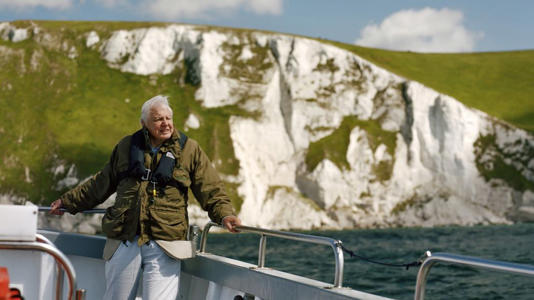
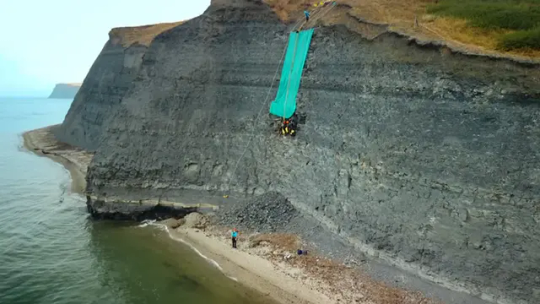
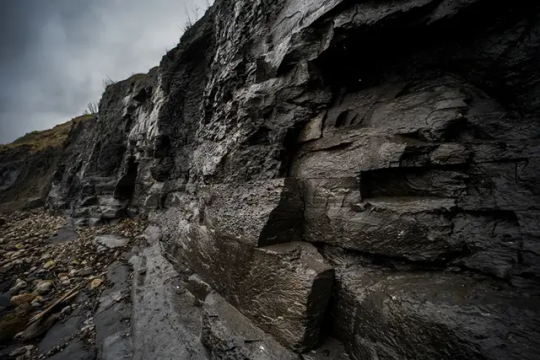
Fearsome top predator of the seas
The nearly intact fossil illuminates the characteristics that made the pliosaur a truly fearsome predator, hunting prey such as the dolphinlike ichthyosaur. The apex predator with huge razor-sharp teeth used a variety of senses, including sensory pits still visible on its skull that may have allowed it to detect changes in water pressure, according to the documentary.
The pliosaur had a bite twice as powerful as a saltwater crocodile, which has the world’s most powerful jaws today, according to Emily Rayfield, a professor of paleobiology at the University of Bristol in the United Kingdom who appeared in the documentary. The prehistoric marine predator would have been able to cut into a car, she said.
Andre Rowe, a postdoctoral research associate of paleobiology at the University of Bristol, added that “the animal would have been so massive that I think it would have been able to prey effectively on anything that was unfortunate enough to be in its space.”
By Issy Ronald.
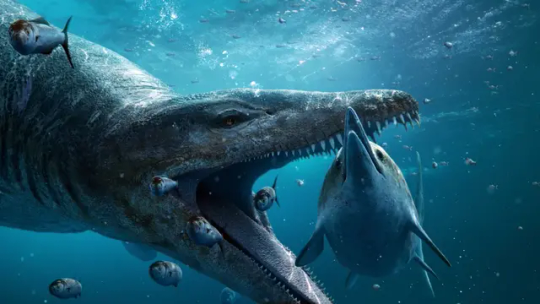
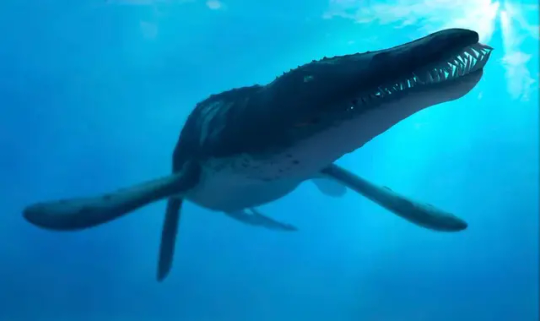
#Gigantic Skull of Prehistoric Sea Monster Found on England’s ‘Jurassic Coast’#Dorset England#pliosaur#jurassic#fossil#prehistoric#dinosaur#paleobiology#palaeontologists#archaeology#archeolgst#history#history news#ancient history#Sir David Attenborough#nature#naturalist
2K notes
·
View notes
Text
Fossil Crocs of 2024
Another year another list of new fossil crocodilians that greatly expand our knowledge of Pseudosuchia across deep time. Happy to say that this is my third time doing this now, so I'm not going to bog you down with the details and get right into it.
Benggwigwishingasuchus
Our first entry, sorted by geological age of course, is Benggwigwishingasuchus eremicarminis (desert song fishing crocodile) from the Middle Triassic (Anisian) of Nevada. It was a member of the clade Poposauroidea, which some of you might recognize as also containing such bizarre early croc cousins like Arizonasaurus and Effigia. Also notable about Benggwigwishingasuchus is that it was found in the Fossil Hill Member of the Favret Formation. Why is that notable? Well the Fossil Hill Member preserves an environment deposited 10 km off the Triassic coastline and also yielded fossils of animals like Cymbospondylus, the giant ichthyosaur. Despite this however, Benggwigwishingasuchus shows no obvious signs of having been a swimmer or diver. Instead, its been hypothesized that it was simply foraging around the coast and might have been washed out to sea.
Artwork by Joschua Knüppe (@knuppitalism-with-ue) and Jorge A. Gonzalez
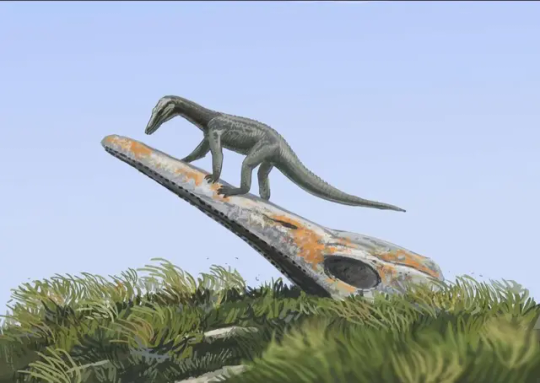
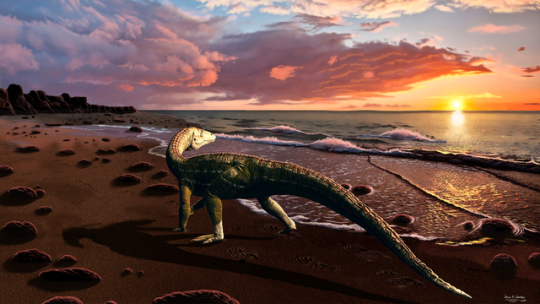
Parvosuchus
Fast forward some 5 million years to the Ladinian - Carnian of Brazil, specifically the Santa Maria Formation. Here you'll find the one new genus on the list I did not write the wikipedia page for: Parvosuchus aurelioi (Aurélio's Small Crocodile). With only a meter in length, Parvosuchus is amongst the smallest pseudosuchians of the year and a member of the aptly named Gracilisuchidae. Santa Maria was actually home to multiple pseudosuchians, including the mighty Prestosuchus (and its possible juvenile form Decuriasuchus), the small erpetosuchid Archeopelta and larger Pagosvenator and one more...
Artwork by Matheus Fernandes and Joschua Knüppe
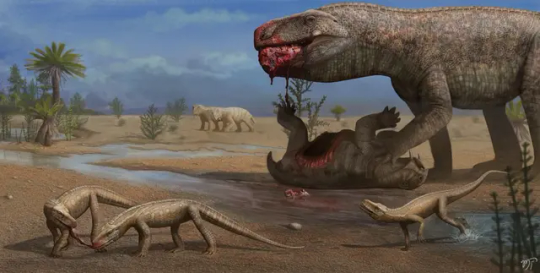

Schultzsuchus
Yup, Santa Maria has been eating good this year. Before the description of Parvosuchus, scientists coined the name Schultzsuchus loricatus (Schultz's Crocodile). Now this one's not entirely new and has long been known under the name Prestosuchus loricatus (by which I mean since 1938). What's interesting is that this new redescription suggests that rather than being a Loricatan, Schultzsuchus was actually an early member of Poposauroidea like Benggwigwishingasuchus. Even if it was no longer thought to be close to Prestosuchus, it was liekly still a formidable predator and among the larger pseudosuchians of the formation.
Artwork by Felipe Alves Elias

Garzapelta
Our last Triassic pseudosuchian and our only aetosaur of the year came to us in the form of Garzapelta muelleri (Mueller's Garza County Shield). It comes from the Late Triassic (Norian) Cooper Canyon Formation of, you guessed it, Garza County, Texas. As an aetosaur, the osteoderms are already regarded as diagnostic, tho unlike some other recent examples there is a little more material to go off from. It's still primarily osteoderms, but at least a good amount and even some ribs.
Artwork by Márcio L. Castro

Ophiussasuchus
Our only Jurassic newcommer is Ophiussasuchus paimogonectes (Paimogo Beach Swimmer Portuguese Crocodile), but arguably you couldn't find a better posterchild for Jurassic crocodyliforms. This new lad is a goniopholidid from the Kimmeridgian to Tithonian Lourinhã Formation, yup, Europe's Morrison. It's anatomy is perhaps not the most exciting, like other goniopholidids it had a flattened, very crocodilian-esque snout and was likely semi-aquatic like its relatives.
Artwork by @manusuchus and Joschua Knüppe


Enalioetes
Another quintessential group of Jurassic crocodyliforms are the metriorhynchoids, however, 2024's only new addition to this clade was actually Cretaceous, specifically from the earliest Cretaceous (Valanginian) of Germany. Like Schultzsuchus, Enalioetes schroederi (Schroeder's Sea Dweller) is new in name only, as fossil material has been found at the latest in 1918 and given the name Enaliosuchus "schroederi" in 1936. This kickstarted a whole series of taxonomic back and forth until the recent redescriptoin finally just gave it a new name and settled things (for now). Looking back I realize that I really need to take the time and fix up the Wikipedia page. Tho I've written its current status, I was kinda limited by being on vacation and never dived into the description section.
Artwork by Joschua Knüppe and Jackosaurus
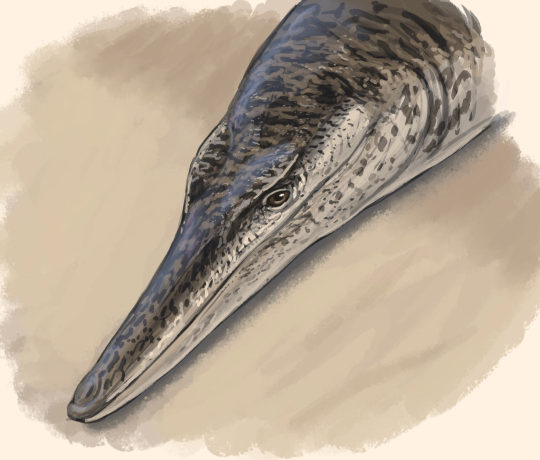

Varanosuchus
Another Early Cretaceous crocodyliform is Varanosuchus sakonnakhonensis (Monitor Lizard Crocodile from the Sakon Nakhon Province), described from Thailand's Sao Khua Formation. It lived around the same time as Enalioetes, but otherwise couldn't have been more different. Where Enalioetes was fully marine, Varanosuchus was more a land dweller as evidenced by the deep skull and long, slender legs. At the same time, some other features, like its more robust limbs compared to its kin, might suggest that Varanosuchus could have still spent some time in the water like some modern lizards. Tho one might be reminded of Parvosuchus from earlier, Varanosuchus is a much more recent example of small terrestrial croc-relatives, the atoposaurids, which are much closer to todays crocodiles and alligators.
Artwork once again by Manusuchus

Araripesuchus manzanensis
Yet another example of a small, gracile land "crocodile" comes to us in the form of Araripesuchus manzanensis (Araripe Basin Crocodile from the El Manzano Farm). And once again, it belonged to a completely different group, this time the notosuchian family Uruguaysuchidae. Now Araripesuchus is well known as a genus, in part due to the work of Paul Sereno and Hans Larsson (who popularized the names "dog croc" and "rat croc" for two species). Tangent aside, A. manzanensis is known from the upper layers of Argentina's Candeleros Formation, corresponding to the Cenomanian (earliest Late Cretaceous). The same locality also yielded A. buitreraensis, from which A. manzanensis can be distinguished on account of its blunt molariform teeth in the back of its jaw. This dentition, which corresponds to a durophageous diet of hardshelled prey, could explain how it coexisted with the related A. buitrensis at the same locality, allowing the two to occupy different niches. There is a neat little animation done for this animal you can watch here.
Artwork by Gabriel Diaz Yantén

Caipirasuchus catanduvensis
We're staying in South America but moving to Brazil's Adamantina Formation for our next entry: Caipirasuchus catanduvensis (Caipiras Crocodile from Catanduva). This one is a little more recent, tho the age of the Adamantina Formation is a bit of a mess far as I can tell, ranging anywhere from the Turonian to the Maastrichtian. One could also argue that C. catanduvensis is part of the "lanky small croc club" that Parvosuchus, Varanosuchus and A. manzanensis belong to, but I feel that the very short snout helps it stand out from that bunch more easily. Anyhow, Caipirasuchus catanduvensis is a member of Sphagesauridae, related to Armadillosuchus, and herbivorous. What's really interesting tho is that the internal anatomy suggests the presence of resonance chambers not unlike that of hadrosaurs, possibly suggesting that these animals were quite vocal. This could also explain why baurusuchids appear to have had very keen hearing.
Artwork by Joschua Knüppe and Guilherme Gehr
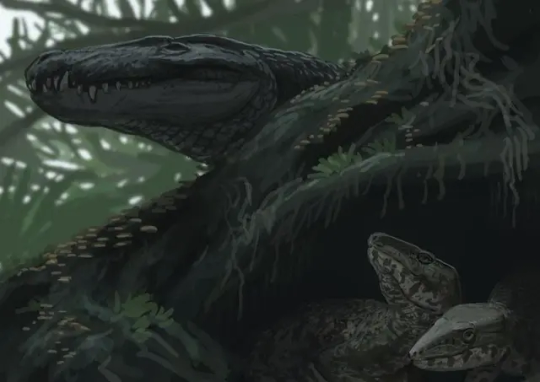

Epoidesuchus
We're staying in the Adamantina Formation for our last Mesozoic croc of the year, Epoidesuchus tavaresae (Tavares' Enchanted Crocodile). Tho also a Notosuchian like Araripesuchus and Caipirasuchus, this one belongs to the family Itasuchidae (or the subfamily Pepesuchinae depending on who you ask), which stand out as being rare examples of semi-aquatic members of this otherwise largely terrestrial group. Epoidesuchus was fairly large for its kin and had long, slender jaws. Like I said, Epoidesuchus and its relatives were likely more semi-aquatic than other notosuchians, something that might explain the relative lack of semi-aquatic neosuchians across Gondwana. They aren't absent mind you, but noticably rarer than they are in the northern hemisphere.
Artwork by Guilherme Gehr

And thus we move into the Cenozoic and towards the end our or little list. From here on out, say goodbye to Notosuchians or other weird crocodylomorphs and get ready for Crocodilia far as the eye can see.
Ahdeskatanka
The first Cenozoic croc we got is Ahdeskatanka russlanddeutsche (Russian-German Alligator), which despite its name comes from North Dakota, specifically the Early Eocene Golden Valley Formation. Ahdeskatanka is similar to many early alligatorines like Allognathosuchus in being small with rounded, globular teeth that suggest that it fed on hardshelled prey. This would have definitely helped avoid competition in the Golden Valley Formation, which also housed a second, similar form not yet named, a large generalist with a V-shaped snout similar to Borealosuchus and the generalized early caiman Chrysochampsa, also large but with a U-shaped snout.
Artwork by meeeeeeee

Asiatosuchus oenotriensis
We had an alligatoroid, so now its time for a crocodyloid. Asiatosuchus has been recognized from the Late Eocene Duero Basin of Spain for a while now, but now we have a name: Asiatosuchus oenotriensis (Asian Crocodile Belonging To The Land Of Wine). Asiatosuchus is a complex genus, most often not really forming a monophyletic clade and likely representing several distinct or at least successive taxa that form the "Asiatosuchus-like complex". Within this complex, A. oenotriensis is thought to have been close-ish to Germany's Asiatosuchus germanicus.
Artwork by Manusuchus

Sutekhsuchus
Rounding out the trio of major crocodilian clades is Sutekhsuchus dowsoni (Set's Crocodile/God of Deception Crocodile), representing our only gavialoid of the year. Originally described as Tomistoma dowsoni in 1920 based on fossil remains from the Miocene of Egypt, Sutekhsuchus has been at times regarded as distinct and at other times lumped into Tomistoma lusitanica. It was one of several early gavialoids to inhabit the coast of the Tethys during the Miocene and appears to have been most closely related to the genus Eogavialis, clading together just outside of the American and Asian gharials. A fun little personal anecdote, I prematurely learned about this one due to a friend highlighting the name in a study on Eogavialis. Never having heard of "Sutekhsuchus" I took to google scholar, where I found a single result: a reference to the then unpublished description, which naturally I ended up eagerly awaiting.
Artwork by Manusuchus and Joschua Knüppe
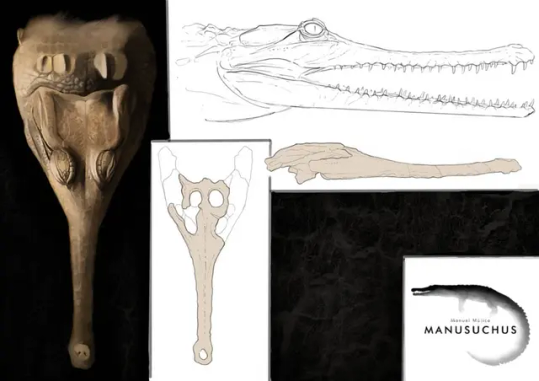
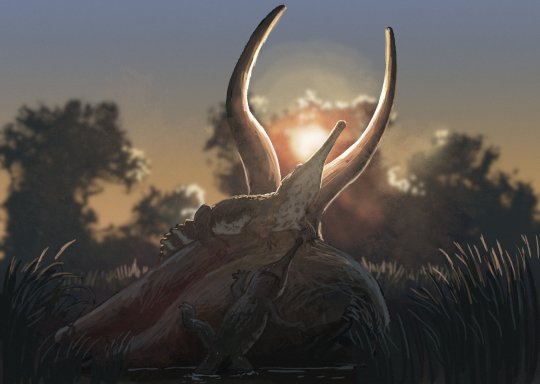
Paranacaiman
Two more and we're done. First, completely arbitrarily, Paranacaiman bravardi (Bravard's Caiman from Parana) from the Miocene Ituzaingo Formation of Argentina. Material of this genus has originally been referred to Caiman lutescens, described in 1912 but now considered a nomen dubium. Paranacaiman is known from limited material only, just the skull table, but that would indicate a "huge" animal. My personal scaling recovered a size of almost 5 meters in length, similar to large black caimans today.
Once again, credit to me

Paranasuchus
Last but not least, Paranasuchus gasparinae (Gasparini's Crocodile from Parana). Coming from the same deposits as Paranacaiman, this one too has been known as a species of Caiman for some time before being assigned its own genus, though it at least got to retain its old species name. Alas, I have not scaled it myself, tho its material is at least more extensive than that of Paranacaiman, including even parts of the snout. A little nitpick because I don't have much to say, but I personally think the name was ill conceived. On its own both Paranacaiman and Paranasuchus are fine names don't get me wrong, but together, coined by the same authors in the same study no less, they strike me as needlessly confusing to non experts. Both are caimans, both are from Parana, so the distinction between "Parana Caiman" and "Parana Crocodile" is entirely arbitrary and doesn't really distinguish them. Not helped by the fact that they are even closely related in the original description. Other than that tho another good addition to our understanding of fossil crocs.
No artwork on this one, but fossil material from Bona et al. 2024

And that wraps up 2024. I hope This post, or my posts throughout the year or even my work on Wikipedia has helped to make these fascinating animals just a little bit more approachable and a massive thanks to all the artists who took their time to create fantastic pieces featuring these incredible animals. Special shout outs to Manusuchus, who diligently illustrated a lot of the featured animals and Joschua Knüppe, who had to listen to me suggest Ahdeskatanka every Sunday for about two months straight now.
Fossil Crocs of 2023
Fossil Crocs of 2022
#paranasuchus#paranacaiman#ahdeskatanka#sutekhsuchus#ophiussasuchus#epoidesuchus#caipirasuchus#araripesuchus#enalioetes#parvosuchus#benggwigwishingasuchus#schultzsuchus#garzapelta#varanosuchus#paleontology#prehistory#palaeoblr#long post#fossil crocs of 2024#paleo#paleonotlogy#crocodilia#crocodylomorpha#pseudosuchia#fossils#2024
260 notes
·
View notes
Text
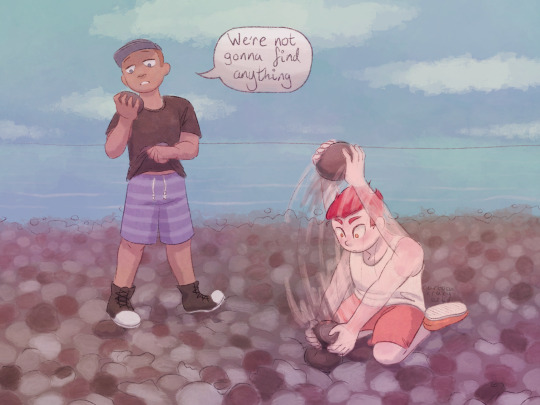
Bullymagnet Week Day 4: Beach Day
Visited the jurassic coast recently so uhhhh here's some fossil huntin' boys
[Image description: a digital drawing of Johnny and Max from Paranatural on a rocky beach. Johnny is kneeling on the ground, smashing a rock into another with wide eyes. Max is standing behind him with arm armful of rocks, looking bored. He says "we're not gonna find anything." End ID]
#bullymagnet week#bulmagwe 2025#bullymagnet#johnny jhonny#maxwell puckett#they never saw it and went home without it#did you see it?
33 notes
·
View notes
Text

꩜ integrating its arrival
prayer in the rain
ceremony for the passing seasons
the moss it’s wettest and greenest
the pockets of bright green on the woody floor
the earth shifting seasons
the trees leaves turning from green to brown
the musty scent of the rotten log
alchemising all the blessings of summer
internalising the winter
the rain washes us of the summer
I feel at home in this weather
the aura of nature
darkens with the shorter days
my synesthesia allows me to feel
to hear, the hum of colours
at one with Gaia
guided by her
I repeat what I felt in nature
painting at my mahogany altar
I capture jurassic rainwater in a glass vile
integrating the secrets of the earth with this water
of the lost souls and fossils below
into my paintings somewhere harnessing her energy
Mother Earth
my greatest teacher
Grandmother trees speaking volumes in silence
Older than my human elders
.:.
I rise with the land
I am still with the land
I cry with the land
I worship the land
I grow with this land
The magic Jurassic Coast
Fossils below and Petrified forests in the earth
Magic grown from memories long ago above ground
We are all connected
By the arms of the Mother
Nothing really ends
When life on the surface, grows from the past below
As above
So below
Wild Rose
by Rose Eads
source
#nature#spirituality#artists on tumblr#art#fine art#earth#my art#bohemian#witch#witchcore#cottage living#cottagecore#dark mood#darkcore#dark academia#dark aesthetic#aesthetic#rose eads design#rose eads#Forest#altar#naturecore#dark#earthcore#earth energy#hippy#original writing#creative writing#write#writer
27 notes
·
View notes
Text

A landslide on a Dorset beach has attracted dozens of fossil hunters in search of relics.
Some 200 enthusiasts combed the beach in the village of Charmouth, on the Jurassic Coast, collecting scores of ammonite fossils.
The majority are said to have picked up ammonites, extinct sea molluscs prized for their intricate spiral shells, which measure from 2cm to 2ft and were washed out of the mud and shale by the sea.
Very cool, if you like such things. I know good examples sell to collectors for a tidy price.

13 notes
·
View notes
Text

Breaking News-Last year the 2-meter-long skull of a huge 10 or 12-meter-long pliosaur that lived about 150 million years ago (the creature hasn’t been formally described yet) and had a bite-force of approximately 33,000 newtons was painstakingly unearthed from the face of a cliff in the fossil-rich Jurassic Coast of Dorset, England, and it has now become the subject of a recent David Attenborough documentary that was released just a few days ago. But sad thing is, the original amateur discoverer of the fossil Philip Jacob has not been given credit for this single fascinating find, and now there’s a petition to name the Pliosaur after him.
Let justice be done to Philip Jacobs!
Here is what the living animal would look like when it is compared in size with a human time-traveler.
49 notes
·
View notes
Text
open starter for w / nb ( paleontologist, benefactor, investors' lawyer, etc ) plot jurassic park horror vibes; our muses ( who could already know each other or be meeting for the first time ) have been invited to tour a remote island off the pacific coast of costa rica in hopes of signing off on a billionaire scientist's prehistoric fantasy - what could possibly go wrong?? cue a tropical storm with power outages, dinos running rampant, and some folks being torn to shreds starring evren ozdemir, 27 - 31, paleontologist and carnivore specialist

heart is still aflutter, absolutely giddy over the marvel he's just witnessed. dinosaurs, live dinosaurs, in the flesh, roaming around the island in a casually bliss existence, as if the fossilized reptiles he digs up had never been wiped from the earth. hardly having touched the gourmet lunch provided, evren had been eager to set off on the next part of the tour. "we all know it's unethical to basically play god here, bringing back something nature hand selected to kill off," he concedes, though the boyish smile tugging at the corners of his mouth exposes the surreal high still buzzing in his head. "but i can't say i'm not looking forward to seeing that forty foot long beast of a t-rex." approaching the first fully autonomous jeep, he opens the door for his fellow tourist, head turning to fix mischievous glint in his eye on them. "ride with me?"
#guess who's back on their jp shit 🤡👈#listen just humor me.... i have a mighty need#indie rp#indie horror rp#open starter#⠀⠀⠀*⠀⠀⠀𝐞𝐯𝐫𝐞𝐧⠀⠀𝐨𝐳𝐝𝐞𝐦𝐢𝐫⠀⠀⠀⠀ ...⠀⠀⠀⠀ threads⠀.
2 notes
·
View notes
Photo

AGASSICERAS scipionanum Ammonite Fossil – Upper Pliensbachian Jurassic, Whitby Yorkshire UK
This listing features a well-preserved specimen of AGASSICERAS scipionanum, an elegant ammonite from the Upper Pliensbachian Stage of the Early Jurassic, found near Whitby, North Yorkshire, UK. With its sharp ribbing and compact shape, this ammonite is a superb example of Lower Jurassic cephalopod diversity along the famous Yorkshire Coast.
Fossil Type & Species:
Type: Ammonite (Extinct Marine Cephalopod)
Species: Agassiceras scipionanum
Distinguished by its dense, straight ribbing and narrow discoidal shell
Geological Context:
Era: Mesozoic
Period: Jurassic
Epoch: Early Jurassic
Stage: Upper Pliensbachian (~186 to 183 million years ago)
Formation: Whitby Mudstone Formation
Depositional Environment: Quiet offshore marine setting with finely laminated muds and clays; excellent preservation potential due to frequent anoxic events
Morphological Features:
Sharply ribbed, involute and compressed shell with a small umbilicus
Narrow venter and strongly defined ribs running straight across the flanks
Fine mineralisation may occur in iron oxide or calcite, depending on local preservation
Scientific Importance:
Agassiceras scipionanum is an important biostratigraphic indicator within the Upper Pliensbachian ammonite zones
It plays a role in the definition of key biozones used across Europe in Jurassic stratigraphy
Represents a transitional morphology within evolving ammonite lineages during the Early Jurassic
Locality Information:
Whitby, North Yorkshire, UK – one of the world’s premier fossil localities. The cliffs and foreshore exposures yield an exceptional diversity of ammonites, reptiles, and marine invertebrates from the Lower Jurassic
Authenticity & Display:
All of our fossils are 100% Genuine Specimens and come with a Certificate of Authenticity. The images in this listing show the exact specimen you will receive. Please refer to the photos for full sizing – the scale cube = 1cm.
This is a carefully selected fossil of Agassiceras scipionanum, ideal for collectors of British ammonites, educational settings, or palaeontology enthusiasts.
Own a true piece of Jurassic marine history—over 183 million years old, from the iconic fossil beds of Whitby.
#Agassiceras scipionanum ammonite#Whitby ammonite fossil#Upper Pliensbachian ammonite UK#Yorkshire Jurassic ammonite#certified British ammonite fossil#Lower Jurassic ammonite#rare ammonite fossil UK#ammonite for sale Whitby#British cephalopod fossil#ammonite from Yorkshire coast
0 notes
Text
Open the door, get on the floor
Everybody walk the dinosaur
Welcome to Cretaceous Week! (Dec. 20-26)
If the Earth's history were compressed into a single year, now would mark the Cretaceous Period.

Lasting roughly 79 million years, the Cretaceous Period is the longest period of the Phanerozoic. Though, there is still some debate over when exactly it started.
Geologic periods are usually formally defined by global markers known as index fossils. These fossils are of something that are constrained in time (i.e they show up in the record/go extinct after this point) and are globally distributed. A few different methods of marking the end of the Jurassic have been proposed, ranging from specific foraminifera or ammonites to U-Pb dating of certain rocks. Few of these methods result in an answer that agrees with one another though, so we are stuck with an estimate of 145 million years ago.
The Cretaceous is home for some of the more... charismatic dinosaurs. Triceratops, Stegosaurus, Tyrannosaurus-Rex, Velociraptors, ankylosaurus, and a lot of other dinosaurs that the average child has heard of, lived during this period. Though many didn't walk the earth at the same time. Stegosaurs and Triceratops, for instance, are separated by tens of millions of years of history and would have never seen one another.
Many modern animals and plants can trace their roots back to the Cretaceous. Modern sharks and fish begin to take off in the oceans alongside sea turtles (after their respective starts in the Jurassic), the first members of the families that would become placental mammals and monotremes dug burrows in the undergrowth, and, perhaps most impactful, all flowering plants get their start here before going on to make up the grand majority of modern plants.
The landscape they traveled was a little more familiar to that of today, as Pangaea and Gondwana broke apart in more of a hurry than they had in the Jurassic. South America, India, Antarctica, and Australia all split from Africa at this time, forming the south Atlantic and Indian Oceans in the process. However, the warm climate also meant that there was little ice, even at the poles. This resulted in higher sea levels and the flooding of vast tracks of land to form shallow seas, such as the Western Interior Seaway in North America, or similar formations in Africa and Scandinavia.
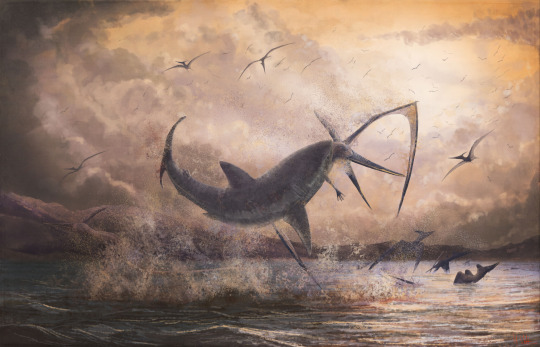
Image Source
While we don't know exactly when the Cretaceous started, we certainly know when it ended: 66 million years ago.
After a gradual decrease in biodiversity that certainly wasn't helped by the Deccan Trapps erupting in India, the non avian dinosaurs, the pterosaurs, and the Plesiosaurs went extinct with the Chicxulub impact off the coast of the Yucatan peninsula. They were not alone. In the resulting impact winter (imagine a nuclear winter sans fallout or humanity) nearly 3/4 of all plant and animal species went extinct due to a collapse of plant life making food relatively scarce. Animals that survived were typically small (less than 55 lbs) and were omnivores, insectivores, or carrion eaters. Crocodilians were an exception to this rule, since river environments rely more on detritus than land plants, and modern crocodiles are capable of going months without food if necessary. Animals on the sea floor were also relatively unaffected.
After the dust finally settled, the survivors would go on to populate the earth, and fill in the niches that dinosaurs left behind. Mammals would radiate into a dizzying variety of forms, birds would continue to take to the skies, life as we know it would slowly begin to take shape. But that is a story for the Cenozoic era.
4 notes
·
View notes
Text
#2798 - Euplectella aspergillum - Venus' Glass Sponge

A particularly beautiful example of a Hexactinellid sponge.
Like most other sponges in the Order, the Venus' Flower Basket lives in the deep ocean, in this case the western Pacific from 100 to 1000m depth. Glass sponges build a lattice-like skeleton from four- or six-sided silica spicules, and the bulk of their living tissue is a single continous cell with many nuclei. That may help when sediment threatens to choke their feeding structures, since they can send an electrical signal across the entire animal to stop sucking in water.
Off the coast of the Pacific Northwest, glass sponges from reefs up to 7km long. This was quite a surprising discovery, given sponge reefs were thought to have been extinct since the Jurassic. Fossil glass sponges have been found in the earliest Cambrian and late Neoproterozoic rocks, and tend to be more common than the soft sponges that are better known today. That's probably just because glass sponges fossilise better.
Glass Sponges often contain a pair of Glass Sponge Shrimp (Fam. Spongicolidae) who clean the inside of the sponge and can never leave thanks to the mesh across the top of the sponge. At least they're safe from predators in there. The shrimp may be why the sponge is a symbol of undying love in Japan, and presented as a wedding gift.
Otago Museum, Dunedin, Aotearoa New Zealand
#glass sponge#venus' glass sponge#Euplectellidae#Euplectella#Hexactinellida#sponge#glass sponge shrimp#Spongicolidae#sponge reef#silica biomaterials#Otago Museum#Dunedin#Dunedin NZ
2 notes
·
View notes
Text
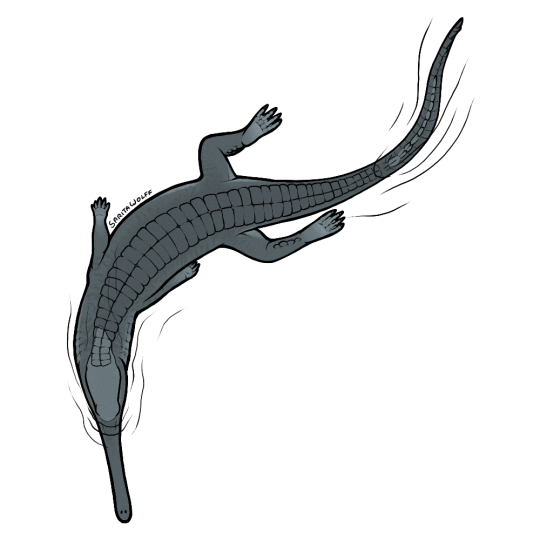
#Archovember Day 11 - Macrospondylus bollensis
The Thalattosuchians were a clade of marine pseudosuchians commonly called “marine crocodiles” or “sea crocodiles”. They were seperated into two groups, the Teleosauroids and the Metriorhynchoids. The metriorhynchoids seemed to be adapted for spending all their time in the water: they had smooth, scale-less skin, tail flukes, and even flippers. Meanwhile, teleosauroids held onto their crocodyliform nature, retaining their osteoderms and probably heading onto land when needed. They inhabited a wide range of habitats: from semi-marine coasts and estuaries, to open-ocean, to freshwater. The Early Jurassic Macrospondylus bollensis was one of these teleosauroids.
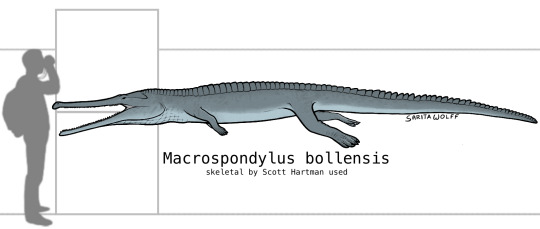
Macrospondylus bollensis, long known as “Steneosaurus bollensis” (Steneosaurus being a wastebasket taxon for thalattosuchians) finally had its genus revived in 2020. At 5.5 m (18 ft), it was the largest known Early Jurassic crocodylomorph. Like many other teleosauroids, it had a long, tapering snout, similar to its modern equivalents the gavialids. This snout would have allowed it to quickly maneuver through the water with little resistance, snapping up fish. Oddly enough, like Megalosaurus, Macrospondylus is also represented in the Crystal Palace gardens (though they are simply labeled as Teleosaurus). Modeled after gharials and based on much better preserved fossils than Megalosaurus, the teleosaur statues actually hold up pretty well, other than using a more crocodilian scute pattern.
Macrospondylus bollensis fossils have been found in Germany, the UK, and Luxembourg. It lived in the newly forming Tethys Sea, which was warm and shallow at the time, dotted with small tropical islands where Macrospondylus would have likely emerged to bask in the sun. This area is known for its fossilized crinoids, cephalopods, bivalves, crustaceans, ichthyosaurs, sharks, bony fish, and more, often exquisitely preserved “frozen in time” due to sudden events and nigh perfect fossilization factors. There was an abundance of fish here for Macrospondylus to feast upon, including chimaeras like Acanthorhina, the armoured Dapedium, the long-bodied Euthynotus, pups of the shark-like Hybodus, the herring-like Leptolepis, and many more. It would have lived alongside a variety of icthyosaurs, small plesiosaurs, and other teleosauroids such as Mystriosaurus, Pelagosaurus, and Platysuchus, pterosaurs such as Campylognathoides and Dorygnathus, and come across sauropods such as Ohmdenosaurus wandering the shorelines. But Macrospondylus was not the biggest “fish” in the sea, and if it ventured into the open ocean it could have come across the 8–10 metre (26–33 ft) long icthyosaur Temnodontosaurus, the apex predator of the Early Jurassic Tethys Sea (which is also on display at the Crystal Palace!)
#my art#SaritaDrawsPalaeo#Macrospondylus#Macrospondylus bollensis#Teleosauroid#Teleosaur#Thalattosuchians#Crocodyliforms#pseudosuchians#archosaurs#archosauromorphs#reptiles#Archovember#Archovember2023
11 notes
·
View notes
Text

Ammonite at the museum
Unknown, Portrait of Mary Anning with her dog Tray and the Golden Cap outcrop in the background, before 1842, Natural History Museum, London
Mary Anning (1799–1847) was an English fossil collector, dealer, and Paleontologist. She became known internationally for her discoveries in Jurassic marine fossil beds in the cliffs along the English coast at Lyme Regis. Her findings contributed to changes in scientific thinking about prehistoric life and the history of the Earth. Anning died from breast cancer at the age of 47.
#art history#art history memes#dad jokes#punny#puns#punsarelikeonions#art meme#women in art#museum nerd#women in science#breast cancer awareness#get a damn mammogram
2 notes
·
View notes
Photo

(XユーザーのGeology Tweetsさん: 「Rare beautiful golden pyrite ammonite fossils from the world famous Jurassic Coast beach of Charmouth, Dorset UK. Photo : 📷 Fms.fossils. Dr Fiann Smithwick https://t.co/J4BpEiV4gK」 / Twitterから)
2 notes
·
View notes
Text
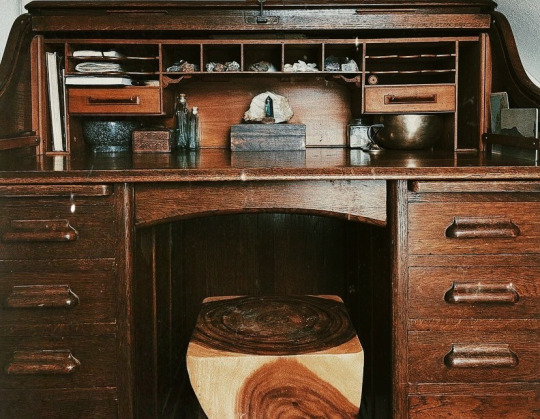
Last year I discovered this huge junk shop full of antique treasures, like the old man’s shop from Whisper of the Heart. Feeling like Shizuku, I ended up purchasing a 130 year old Edwardian drawing desk that was made in London back in about 1907.
Sadly, I was going to resell it after feeling energetically like it never belonged to me. But after a year, it’s like a spell has broken or something, its essence has altered and it’s allowed itself to suddenly feel, like it belongs to me.
So, for the last week I’ve been dressing it, getting to know its cracks, scents, sounds, magic and history. It feels open and free now. Honestly before it locked me out twice where I left the key inside and my goodness it takes about five hours to get back in. See the resistance?! But now, it’s at peace in my home and open to me.
I live on the Jurassic Coast and if you don’t know what that is, it’s long stretch of ancient land in gloomy England that’s home to fossils, thousands of ammonites, dinosaurs and petrified wood forests. The land is holy and laced with history. So, as a tribute to this land I live on, I will create my own wunderkammer.
A Cabinet of Curiosity for the fossils found on this land. A home to inspire me when I paint my sacred circles. I’ve painted 140 so far. I made a mini vlog if you want to meet the desk and another will follow when I’ve finished filling it with fossils. Watch it here.
Wild Rose
#nature#spirituality#artists on tumblr#art#fine art#abstract art#earth#my art#abstract painting#bohemian#fossil#fossils#edwardian#history#furniture#antiques#interior design#witch vibes#cottage witch#forest witch#witchcore#crystals magic#trees#art studio#folk art#artist#archaeology#artifact
4 notes
·
View notes